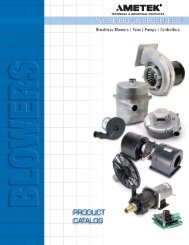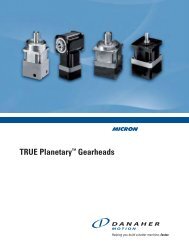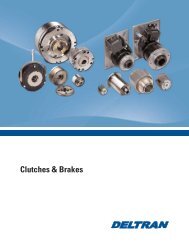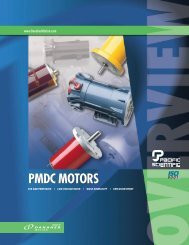Profile Rail Linear Guides
Profile Rail Linear Guides
Profile Rail Linear Guides
Create successful ePaper yourself
Turn your PDF publications into a flip-book with our unique Google optimized e-Paper software.
<strong>Linear</strong> Motion. Optimized.<br />
<strong>Profile</strong> <strong>Rail</strong> <strong>Linear</strong> <strong>Guides</strong><br />
Sizing & Defining Guide Characteristics<br />
The following 9 step procedure can be used to select the<br />
characteristics necessary to generate the appropriate<br />
part number :<br />
1. Determine the load on the most heavily loaded carriage<br />
or bearing (see Applied Loading Calculations). Multiply<br />
by a safety factor if desired in your application.<br />
2. Determine the minimum required travel life for the<br />
application based on the intended duty cycle.<br />
3. Calculate the Minimum Required Dynamic Load<br />
Rating, C min (see Page 88).<br />
4. Select the size which offers the load rating, C, equal<br />
to or greater than the minimum required dynamic load<br />
rating, C min . Also, consider Dynamic Load Limit and<br />
Static Capacities.<br />
5. If the guide selected offers various preload † levels,<br />
select a preload based upon the allowable bearing<br />
deflection. Contact the factory for detailed deflection<br />
information. Some carriage or bearing Deflection<br />
Charts are provided in this catalog.<br />
6. If the guide selected offers various accuracy classes,<br />
select an accuracy class based upon the required<br />
travel accuracy.<br />
7. Determine the need for accessories or options.<br />
8. Calculate the guide length based upon the stroke<br />
and platten length. Remember to include additional<br />
length of accessories (i.e. self-lubricating option) and<br />
the stroke reduction caused by the use of bellows, if<br />
applicable.<br />
9. Once the above characteristics have been determined,<br />
assign the appropriate part number based on the part<br />
numbering instructions located in the catalog section<br />
corresponding to the linear guide selected.<br />
† Choosing a higher preload level will reduce the allowable installation<br />
tolerances. For this reason, the minimum preload which meets<br />
the applications requirements should be selected. If the highest<br />
preload level does not meet the deflection requirements, a larger<br />
size may be required.<br />
98<br />
www.thomsonlinear.com











